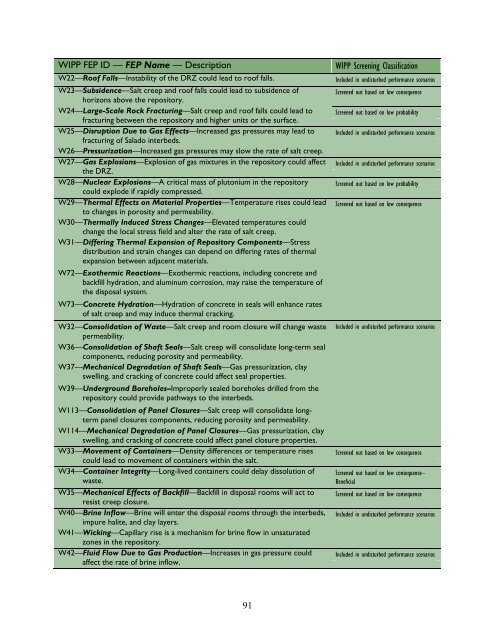Salt Disposal of Heat-Generating Nuclear Waste
Salt Disposal of Heat-Generating Nuclear Waste
Salt Disposal of Heat-Generating Nuclear Waste
You also want an ePaper? Increase the reach of your titles
YUMPU automatically turns print PDFs into web optimized ePapers that Google loves.
WIPP FEP ID — FEP Name — Description<br />
W22—Ro<strong>of</strong> Falls—Instability <strong>of</strong> the DRZ could lead to ro<strong>of</strong> falls.<br />
W23—Subsidence—<strong>Salt</strong> creep and ro<strong>of</strong> falls could lead to subsidence <strong>of</strong><br />
horizons above the repository.<br />
W24—Large-Scale Rock Fracturing—<strong>Salt</strong> creep and ro<strong>of</strong> falls could lead to<br />
fracturing between the repository and higher units or the surface.<br />
W25—Disruption Due to Gas Effects—Increased gas pressures may lead to<br />
fracturing <strong>of</strong> Salado interbeds.<br />
W26—Pressurization—Increased gas pressures may slow the rate <strong>of</strong> salt creep.<br />
W27—Gas Explosions—Explosion <strong>of</strong> gas mixtures in the repository could affect<br />
the DRZ.<br />
W28—<strong>Nuclear</strong> Explosions—A critical mass <strong>of</strong> plutonium in the repository<br />
could explode if rapidly compressed.<br />
W29—Thermal Effects on Material Properties—Temperature rises could lead<br />
to changes in porosity and permeability.<br />
W30—Thermally Induced Stress Changes—Elevated temperatures could<br />
change the local stress field and alter the rate <strong>of</strong> salt creep.<br />
W31—Differing Thermal Expansion <strong>of</strong> Repository Components—Stress<br />
distribution and strain changes can depend on differing rates <strong>of</strong> thermal<br />
expansion between adjacent materials.<br />
W72—Exothermic Reactions—Exothermic reactions, including concrete and<br />
backfill hydration, and aluminum corrosion, may raise the temperature <strong>of</strong><br />
the disposal system.<br />
W73—Concrete Hydration—Hydration <strong>of</strong> concrete in seals will enhance rates<br />
<strong>of</strong> salt creep and may induce thermal cracking.<br />
W32—Consolidation <strong>of</strong> <strong>Waste</strong>—<strong>Salt</strong> creep and room closure will change waste<br />
permeability.<br />
W36—Consolidation <strong>of</strong> Shaft Seals—<strong>Salt</strong> creep will consolidate long-term seal<br />
components, reducing porosity and permeability.<br />
W37—Mechanical Degradation <strong>of</strong> Shaft Seals—Gas pressurization, clay<br />
swelling, and cracking <strong>of</strong> concrete could affect seal properties.<br />
W39—Underground Boreholes–Improperly sealed boreholes drilled from the<br />
repository could provide pathways to the interbeds.<br />
W113—Consolidation <strong>of</strong> Panel Closures—<strong>Salt</strong> creep will consolidate longterm<br />
panel closures components, reducing porosity and permeability.<br />
W114—Mechanical Degradation <strong>of</strong> Panel Closures—Gas pressurization, clay<br />
swelling, and cracking <strong>of</strong> concrete could affect panel closure properties.<br />
W33—Movement <strong>of</strong> Containers—Density differences or temperature rises<br />
could lead to movement <strong>of</strong> containers within the salt.<br />
W34—Container Integrity—Long-lived containers could delay dissolution <strong>of</strong><br />
waste.<br />
W35—Mechanical Effects <strong>of</strong> Backfill—Backfill in disposal rooms will act to<br />
resist creep closure.<br />
W40—Brine Inflow—Brine will enter the disposal rooms through the interbeds,<br />
impure halite, and clay layers.<br />
W41—Wicking—Capillary rise is a mechanism for brine flow in unsaturated<br />
zones in the repository.<br />
W42—Fluid Flow Due to Gas Production—Increases in gas pressure could<br />
affect the rate <strong>of</strong> brine inflow.<br />
WIPP Screening Classification<br />
Included in undisturbed performance scenarios<br />
Screened out based on low consequence<br />
Screened out based on low probability<br />
Included in undisturbed performance scenarios<br />
Included in undisturbed performance scenarios<br />
Screened out based on low probability<br />
Screened out based on low consequence<br />
Included in undisturbed performance scenarios<br />
Screened out based on low consequence<br />
Screened out based on low consequence–<br />
Beneficial<br />
Screened out based on low consequence<br />
Included in undisturbed performance scenarios<br />
Included in undisturbed performance scenarios<br />
91
















